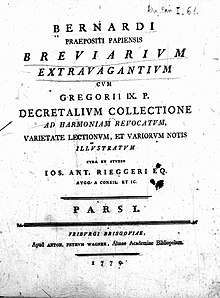Decretalist
In the history of canon law, the decretalists of the thirteenth century formed a school of interpretation that emphasised the decretals, those letters issued by the Popes ruling on matters of church discipline (epistolae decretales), in preference to the Decretum Gratiani (1141), which their rivals, the decretists, favoured.[1] The decretalists were early compilers of the papal decretals, and their work, such as that of Simon of Bisignano (c. 1177), was used by the dominant decretist school.[2]
 |
| Part of a series on the |
| Canon law of the Catholic Church |
|---|
|
Jus antiquum (c. 33-1140)
Jus novum (c. 1140-1563) Jus novissimum (c. 1563-1918) Jus codicis (1918-present) Other |
|
Sacraments
Sacred places
Sacred times |
|
|
Supreme authority, particular churches, and canonical structures Supreme authority of the Church
Supra-diocesan/eparchal structures
|
|
|
Temporal goods (property) |
|
Canonical documents |
|
Procedural law Pars statica (tribunals & ministers/parties)
Pars dynamica (trial procedure)
Election of the Roman Pontiff |
|
Legal practice and scholarship
Academic degrees Journals and Professional Societies Faculties of canon law
Canonists |
|
|
The decretalist practice can be divided into three periods. The first (c. 1160–1200) is characterised by the collection of decretals; the second (c. 1200–1234) by the organisation of the collections and the first signs of decretal exegesis; and the final (1234–1348) by extensive exegesis and analysis.[2] Important early decretalists include Bernard of Pavia, who wrote the Summa Decretalium, the Summa de Matrimonio and the Brevarium Extravagantium, and Henry of Susa, whose Summa Copiosa melded canon law with Roman law and was influential into modern times.[1]
 Bernardus Papiensis, Breviarium extravagantium, 1779
Bernardus Papiensis, Breviarium extravagantium, 1779
Notes
- Rhidian Jones, The Canon Law of the Roman Catholic Church and the Church of England: A Handbook (T&T Clark, 2000), 45–46.
- "Decretalist", New Catholic Encyclopedia (Gale, 2002).